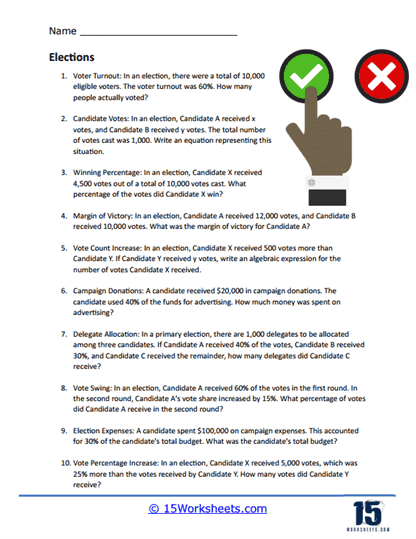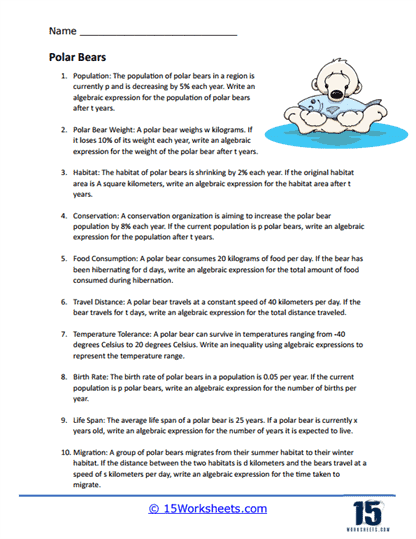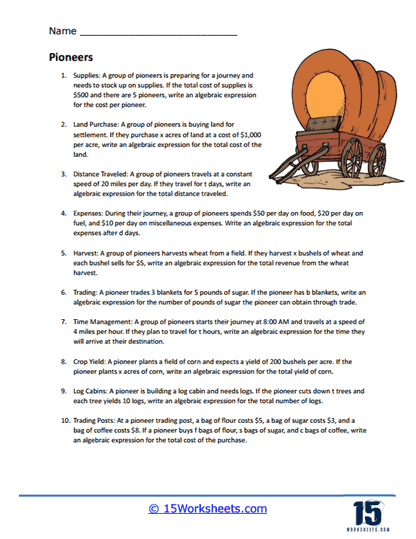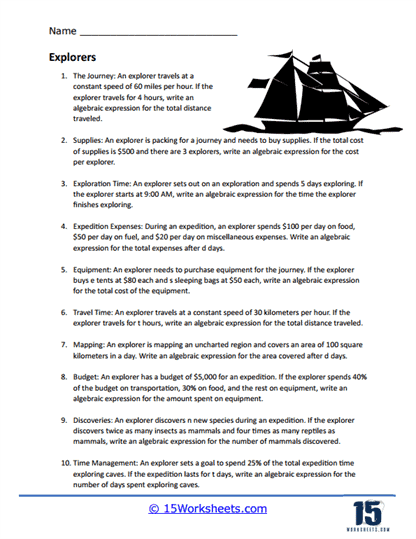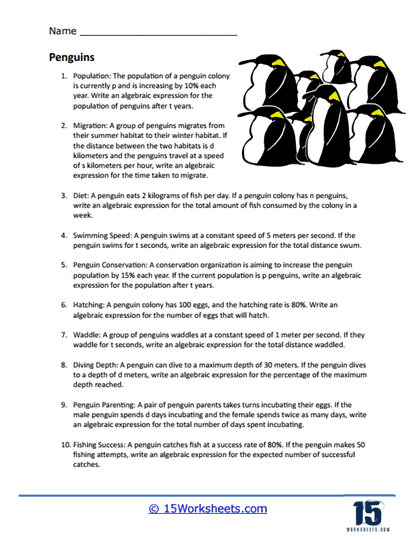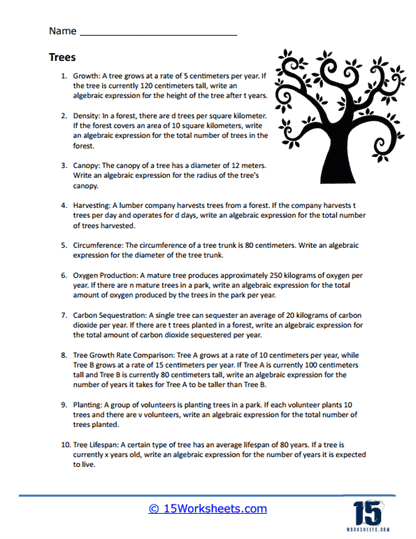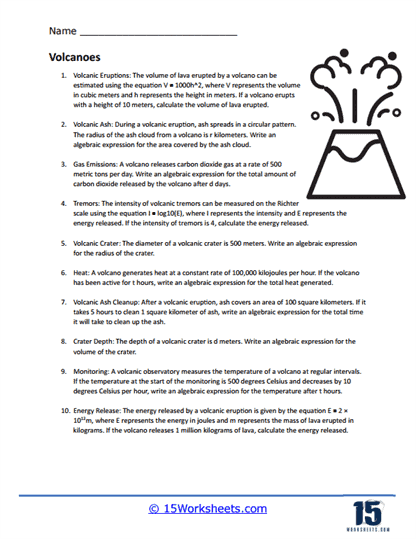Algebra Word Problems Worksheets
About These 15 Worksheets
These worksheets are educational materials designed to help students practice and improve their algebraic problem-solving skills through real-life scenarios and contextual situations. These worksheets typically consist of a series of word problems that require students to translate written information into mathematical expressions and equations, and then solve for unknown variables. The problems often cover various algebraic concepts such as linear equations, inequalities, systems of equations, quadratic equations, and more.
Algebra word problem worksheets serve as a valuable tool for educators to assess students’ comprehension of algebraic concepts and their ability to apply them in practical situations. They also help students develop critical thinking skills and apply algebraic principles to solve everyday problems, making the learning process more engaging and relevant to their lives. These worksheets are commonly used in classrooms, as homework assignments, or as part of standardized test preparation to ensure students have a strong foundation in algebraic problem-solving.
What Are Algebra Word Problems?
Algebra word problems are mathematical problems that involve real-life situations and are presented in the form of words or narratives. These problems require the application of algebraic concepts and techniques to solve them. The goal is to translate the given information into mathematical equations or expressions and then use algebraic methods to find the solution.
Algebra word problems often involve variables, unknown quantities, and relationships between different quantities. They may cover various topics, such as equations, inequalities, systems of equations, functions, ratios, proportions, and percentages. These problems can be found in many areas, including finance, physics, engineering, and everyday situations.
On these worksheets, you’ll be asked to use your algebraic superpowers to answer questions like: “If 2 times a number plus 5 equals 11, what is the number?” or “Solve for ‘y’ in the equation 3y – 7 = 20.” You might even stumble upon intriguing challenges like, “If Sally has twice as many apples as Tom, and together they have 18 apples, how many apples does each of them have?”
Example Algebra Word Problems
Problem (Easy): Lila is three times as old as her younger sister, Mia. The sum of their ages is 24 years. How old is each of them?
Solution: Let’s call Lila’s age L and Mia’s age M.
We can set up two equations based on the given information:
L = 3M (Lila is three times as old as Mia)
L + M = 24 (The sum of their ages is 24 years)
Now, we can use substitution to solve for their ages. From equation (1), we can express L in terms of M:
L = 3M
Now, substitute this expression for L into equation (2): 3M + M = 24
Combine like terms: 4M = 24
Now, divide both sides by 4 to solve for M: M = 24 / 4
M = 6
So, Mia is 6 years old. Now, use this value to find Lila’s age using equation (1):
L = 3M
L = 3 x 6
L = 18
Lila is 18 years old.
Problem 2 (Intermediate): A car rental company charges a flat fee of $40 per day plus an additional $0.25 per mile driven. If a customer rents a car and pays a total of $95, how many miles did they drive?
Solution: Let’s call the total number of miles driven M and the total cost C. We can set up an equation based on the given information:
C = 40 + 0.25M
We know the total cost is $95, so we can substitute that into the equation:
95 = 40 + 0.25M
Now, subtract 40 from both sides to isolate 0.25M:
55 = 0.25M
To find M, divide both sides by 0.25:
M = 55 / 0.25
M = 220
So, the customer drove 220 miles.
Tips For Solving These Types of Problems
Translate Into Equations or Expressions
Understand the problem by reading it multiple times. Identify the key information, such as quantities, relationships, and the question being asked. Pay attention to keywords that indicate mathematical operations (e.g., “sum,” “product,” “difference”) and make note of any constraints or conditions mentioned. Assign variables to represent the unknown quantities in the problem. Choose appropriate letters to represent these variables and clearly define their meanings.
Convert the given information into mathematical equations or expressions. Use the identified variables and the relationships described in the problem to set up the equations. Apply algebraic techniques to simplify the equations or expressions. This may involve combining like terms, factoring, distributing, or isolating the variable you need to solve for.
Solve
Use algebraic methods to solve the equations and find the value of the unknown variable(s). This may involve solving linear equations, quadratic equations, systems of equations, or other types of equations, depending on the problem. Once you have found a solution, substitute the values back into the original problem to verify if they satisfy all the conditions. Double-check your work to ensure you haven’t made any calculation errors.
In some cases, drawing diagrams or using visual aids, such as graphs or charts, can help you visualize the problem and understand the relationships between different quantities. If a problem seems complex, break it down into smaller, more manageable steps. Solve each part independently, and then combine the solutions to find the final answer.
When Will You Use This Skill In the Real World?
Finance and Economics – Algebraic equations are frequently employed in financial calculations, such as determining interest rates, calculating loan payments, analyzing investments, budgeting, and solving problems related to income, expenses, and profit.
Engineering and Physics – Algebra is vital in engineering and physics for modeling and solving problems related to forces, motion, electricity, circuits, fluid dynamics, and structural analysis. It helps engineers and physicists optimize designs, analyze systems, and make predictions.
Construction and Architecture – Algebra is used in construction and architecture to calculate measurements, angles, areas, volumes, and proportions. It helps professionals plan and design structures, estimate material quantities, and solve geometric problems.
Statistics and Data Analysis – Algebraic concepts play a significant role in statistics and data analysis. Problems involving probability, percentages, averages, trends, and correlation often require algebraic techniques for interpretation and solution.
Business and Marketing – Algebra is utilized in business and marketing to analyze sales data, determine pricing strategies, forecast revenue, and evaluate trends. Algebraic models help in decision-making, optimization, and planning.
Science and Research – Algebra is essential in scientific research, including fields such as biology, chemistry, and environmental science. It aids in analyzing data, developing mathematical models, and solving equations derived from experiments and observations.
Travel and Navigation – Algebraic problem-solving can be applied to navigation problems, such as calculating distances, speeds, travel times, and fuel consumption. It helps in route planning, optimizing travel routes, and understanding motion.
Health and Medicine – Algebra is used in medical research, drug dosage calculations, analyzing patient data, and modeling biological processes. It assists in understanding the relationships between variables, predicting outcomes, and optimizing treatments.
Daily Life Situations – Algebraic problem-solving can be encountered in everyday situations, such as calculating expenses, managing budgets, solving measurement problems, understanding sales and discounts, and planning schedules.




